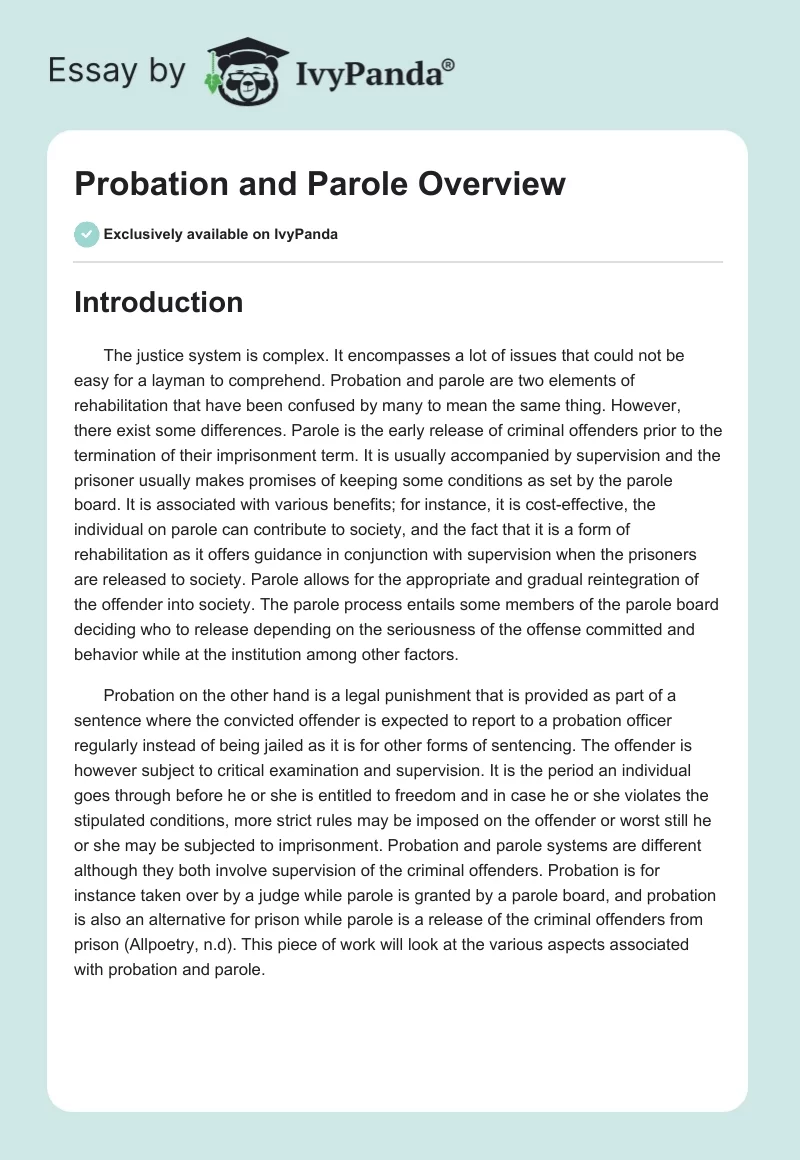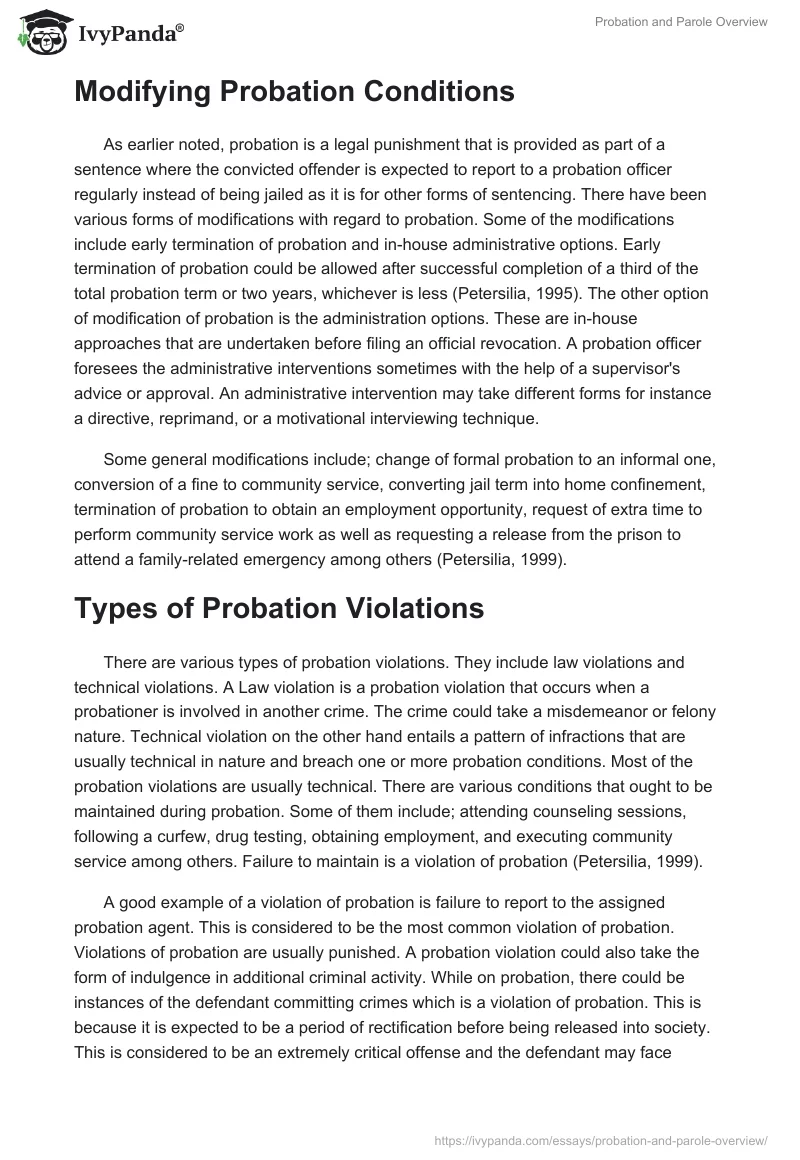Introduction
The justice system is complex. It encompasses a lot of issues that could not be easy for a layman to comprehend. Probation and parole are two elements of rehabilitation that have been confused by many to mean the same thing. However, there exist some differences. Parole is the early release of criminal offenders prior to the termination of their imprisonment term. It is usually accompanied by supervision and the prisoner usually makes promises of keeping some conditions as set by the parole board. It is associated with various benefits; for instance, it is cost-effective, the individual on parole can contribute to society, and the fact that it is a form of rehabilitation as it offers guidance in conjunction with supervision when the prisoners are released to society. Parole allows for the appropriate and gradual reintegration of the offender into society. The parole process entails some members of the parole board deciding who to release depending on the seriousness of the offense committed and behavior while at the institution among other factors.
Probation on the other hand is a legal punishment that is provided as part of a sentence where the convicted offender is expected to report to a probation officer regularly instead of being jailed as it is for other forms of sentencing. The offender is however subject to critical examination and supervision. It is the period an individual goes through before he or she is entitled to freedom and in case he or she violates the stipulated conditions, more strict rules may be imposed on the offender or worst still he or she may be subjected to imprisonment. Probation and parole systems are different although they both involve supervision of the criminal offenders. Probation is for instance taken over by a judge while parole is granted by a parole board, and probation is also an alternative for prison while parole is a release of the criminal offenders from prison (Allpoetry, n.d). This piece of work will look at the various aspects associated with probation and parole.
Modifying Probation Conditions
As earlier noted, probation is a legal punishment that is provided as part of a sentence where the convicted offender is expected to report to a probation officer regularly instead of being jailed as it is for other forms of sentencing. There have been various forms of modifications with regard to probation. Some of the modifications include early termination of probation and in-house administrative options. Early termination of probation could be allowed after successful completion of a third of the total probation term or two years, whichever is less (Petersilia, 1995). The other option of modification of probation is the administration options. These are in-house approaches that are undertaken before filing an official revocation. A probation officer foresees the administrative interventions sometimes with the help of a supervisor’s advice or approval. An administrative intervention may take different forms for instance a directive, reprimand, or a motivational interviewing technique.
Some general modifications include; change of formal probation to an informal one, conversion of a fine to community service, converting jail term into home confinement, termination of probation to obtain an employment opportunity, request of extra time to perform community service work as well as requesting a release from the prison to attend a family-related emergency among others (Petersilia, 1999).
Types of Probation Violations
There are various types of probation violations. They include law violations and technical violations. A Law violation is a probation violation that occurs when a probationer is involved in another crime. The crime could take a misdemeanor or felony nature. Technical violation on the other hand entails a pattern of infractions that are usually technical in nature and breach one or more probation conditions. Most of the probation violations are usually technical. There are various conditions that ought to be maintained during probation. Some of them include; attending counseling sessions, following a curfew, drug testing, obtaining employment, and executing community service among others. Failure to maintain is a violation of probation (Petersilia, 1999).
A good example of a violation of probation is failure to report to the assigned probation agent. This is considered to be the most common violation of probation. Violations of probation are usually punished. A probation violation could also take the form of indulgence in additional criminal activity. While on probation, there could be instances of the defendant committing crimes which is a violation of probation. This is because it is expected to be a period of rectification before being released into society. This is considered to be an extremely critical offense and the defendant may face serious charges when convicted of committing a crime within the probationary period. There are chances of being sentenced for the newly committed crime as well as incarceration for the previous crime (Arrigo and Williams, 2006).
Revocation
Revocation is closely related to probation. It happens when a defendant, for one reason or the other, fails to conform to the terms of the probation. In such a case, the probation is revoked and the individual in question is imprisoned for the remaining period of his or her sentence. A decision to revoke is made depending on the behavior of the defendant. Most revocation decisions are usually discretionary. However, there are cases where some jurisdictions mandate automatic revocation. Revocation is usually done in case an individual violates probation in one way or the other. Revocation could happen when the defendant violates one or more of the probation conditions. The conditions include; executing community service, following a curfew, obtaining employment, drug testing, and attending counseling sessions among others (Duelin, 2010).
Revocation Procedure
A revocation is a form of punishment for violation of probation. The revocation process allows the arrest of the probationers and the parolees whenever there is some form of violation of the probation or parole terms and conditions. Revocation is done in a procedural manner and with justifiable reasons behind it. In case a defendant violates probation, the violation has to be reported to a judge. This is done by either a prosecutor or a probation agent. After the reporting, the judge issues a warrant for the arrest of the defendant. The judge may also propose a date on which the defendant is to come to court. It is after this that a hearing is held and a final decision made. For example, in case the judge finds the defendant guilty of violating the probation, he or she may decide to retain the probation terms, make the probation conditions severe, or else, incarcerate the defendant (revocation). Revocation procedures are governed by agency policy, state or federal law as well as constitutional rules. In cases where a revocation occurs, the time on parole or probation does not depend on the completion of the sentence (Mississippi Department of Corrections, 2011).
Revocation Rights of Probationers and Parolees
Revocation is a complex process. Despite the fact that the probationers and parolees are considered to be in the wrong as a result of a violation of the probation terms, they still have some rights. These involve the right to a lawyer and the right to a hearing. Other rights include the provision of a written notice about the alleged violation, a chance to testify and offer evidence, and the right to judgment by a neutral hearing body, confront and cross-examine witnesses. Probationers and parolees also have the right to a written statement of the final decision that is made with regard to the case in question including the evidence that is used in coming up with the decision.
There is also a requirement that a certain level of proof and disclosure of evidence is provided for revocation to take place. Provision of proof or evidence is considered a burden. The state is required to offer evidence that the defendant violated the terms of probation. However, the situation is not as serious as when criminal cases are involved. The standard of proof is therefore relatively lower in a hearing that involves a violation of probation (Hanser, 2009).
Probation Outcomes
Probation is a crucial process. It is associated with a variety of outcomes. There are different levels of success or failure that are linked to the process of probation. There has been a controversy on the success rates achieved between probationers and parolees. Generally, probation is considered successful for the individuals who are eligible for processes such as misdemeanor and diversion. First-time felons have also shown great improvement when they undergo through probation or parole system. Other populations that have shown a lot of success as a result of probation and parole systems include; women, high schools graduates, those who live with their families, offenders who are 30 years and above as well as those who had prior convictions, either as juvenile or adult offenders.
When comparing the probationers and parolees in terms of success, probationers have shown positive results than the parolees. This is attributed to the fact that probationers commit fewer technical violations and fewer new crimes as compared to the parolees. The probationers are therefore more likely to complete supervision in a successful manner than the parolees irrespective of the crime involved (Miller, 1989).
Conclusion
From the above discussion, it is evident that the elements of probation and parole are critical in the process of maintaining law and order. Although they are usually confused to mean the same, there are some differences. There are various aspects that are associated with parole and probation systems. Different terms and conditions are maintained for instance depending on the crime committed by an individual and the behavior maintained at the correctional institution. Some of the key issues involved with probation and parole include revocation and violations of probation among others. There has been various modifications in the justice system all aimed at improving law enforcement practices. Probation and parole have played a crucial role in streamlining the behavior of the victims as well as ensuring that society is safe. This is achieved through guidance and supervision.
Reference List
Allpoetry (n.d).The Effects of Retribution, Deterrence, Rehabilitation, and Social Protection on American. Web.
Arrigo, B. and Williams, C. (2006). Philosophy, Crime, and Criminology. U.S.A.: University of Illinois Press.
Duelin, D. (2010). Concept of Probation in the Criminal Justice System. Web.
Hanser, D.R. (2009). Community Corrections. New Delhi: SAGE Publications Inc.
Miller, G.J. (1989). The Debate on Rehabilitating Criminals: Is It True that Nothing Works? Web.
Mississippi Department of Corrections (2011). Guide for Victims of Crime – The Parole Process. Web.
Petersilia, J. (1995). A Crime Control Rationale for Reinvesting in Community Corrections. Prison Journal 7 (3): 479-96.
Petersilia, J. (1999). Parole and Prisoner Reentry in the United States. Crime and Justice, Vol. 26, prisons (1999), pp. 479-529.


